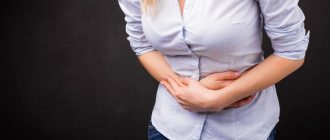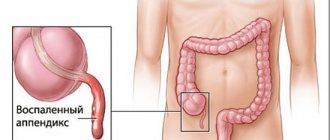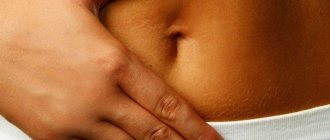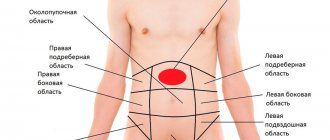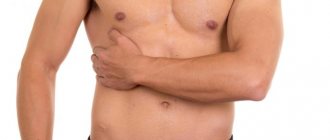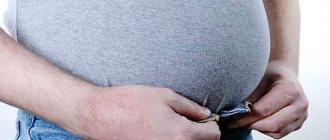What to do when you have pain in the lower abdomen?
Treatment of the disorder
What to do when there is colitis in the lower abdomen or the symptoms of the disease are simply incomprehensible? If acute pain in the abdominal area has an acute manifestation and lasts more than 60 minutes, then you need to urgently call an ambulance. Before the medical team arrives, you must take a calm body position (lie down on a bed or sit in a chair), do not eat food and do not apply various heating pads/compresses. After hospitalization, a gastroenterologist or surgeon may order diagnostic tests.
The mechanism of effective treatment of the disorder is based on the qualitative elimination of pain, namely:
- If the underlying disorder is an infectious disease, the patient will need to undergo antibiotic therapy;
- In case of imbalance of microflora in the intestines, probiotics will help;
- Ulcerative colitis of a nonspecific type is eliminated with the help of immunosuppressants;
- Acute intestinal obstruction and appendicitis in the last stages of the disease are eliminated through surgical intervention in the human body.
Quite often, enzymatic preparations are used to normalize intestinal function. If the pain is very severe (lower abdominal cavity), then the doctor may prescribe antispasmodic drugs. The patient should remember that any pain pills taken are only symptomatic treatment. But the original causes of the disease will not be eliminated. Diseases of the small and large intestines are successfully eliminated with non-steroidal anti-inflammatory drugs.
The storehouse of knowledge of traditional medicine has a large stock of recipes for eliminating pain in the lower abdomen. But even taking a herbal remedy must be agreed with your doctor.
Let's consider several treatment options for the disorder:
- For intestinal atony, a special infusion of honey and aloe leaves is used. To do this, steam 300 g of honey and carefully crush 3 aloe leaves. The mixture is infused for about 24 hours. The “potion” is taken 60 minutes before a meal in a warm form. You can use healthy potato or cabbage juices;
- Use 0.5 tsp. ground green tea leaves (up to 4 times a day) helps normalize intestinal function;
- During intestinal dyskinesia, it is necessary to use a decoction based on a complex herbal mixture. The liquid contains equal parts of mint, motherwort, yarrow flowers, St. John's wort, sage, and oak bark. 2 tbsp. pour 500 ml of boiling water and simmer over low heat for 2 hours. Next, the liquid should be cooled and strained.
Prevention
Any disease that is known to medicine is much easier to prevent. After all, the treatment process can be protracted and provoke the development of various kinds of complications. This is especially true for new formations in the bladder. Women need to be very careful when organizing childbirth
Close attention should be paid to representatives of the fairer sex who have a narrow pelvis and a large fetus (including one located transversely in the womb)
In order to minimize the number of pathologies, it is necessary to adhere to certain rules, namely:
- Maintain personal hygiene standards;
- Do not bring the body to hypothermia;
- Systematically maintain the immune system in good shape (hardening, taking vitamins and minerals);
- Drink water daily (up to several liters per day).
Compliance with the basic rules will prevent the development of a large number of intestinal diseases. The set of these preventive measures includes:
- Balanced diet;
- Complete cessation of bad habits;
- Attentive attitude to medications;
- Creating psychological comfort;
- Effective fight against excess body weight;
- Timely visit to a qualified doctor.
If pain in the lower abdomen is accompanied by prolonged constipation (on the right and left sides), doctors recommend leading an active lifestyle. An effective way is also the process of establishing a regime for emptying the suction organ. You can do a relaxing abdominal massage.
Intestinal adhesions
Adhesions are formations that lead to fusion of the serous membranes of organs. The adhesive process is provoked by abdominal trauma, surgery, inflammatory processes, infections, radiation therapy, and heredity. Signs of the pathological process appear only over time, this is explained by the fact that the process of formation of strands is quite long.
Abdominal pain becomes nagging. Discomfort increases with physical activity. Disruption of the intestines leads to a feeling of distension, bloating, and constipation.
For minor functional disorders, patients are prescribed antispasmodics and analgesics.
In addition, it is extremely important to adhere to dietary nutrition. Fasting and overeating will only aggravate the pathological process
If the blood supply is compromised, immediate surgery will be required. The essence of the surgical intervention comes down to cutting the adhesions.
Adhesions in the intestines cause nagging painPossible intestinal diseases
Depending on the nature of the sensations, spasm may be a sign of the following conditions:
- Aching pain accompanies chronic inflammation of the lower gastrointestinal tract, tumor processes, and obstruction.
- Acute discomfort is one of the points in the clinical picture of ulcerative colitis, appendicitis, and intestinal infection.
- Colic - cramping spasms are present during mechanical damage, poisoning, or parasitic infestation.
If the intestines in the lower abdomen hurt for a long period, two diagnoses are in question - ulcerative colitis and irritable bowel syndrome. Another option is mesenteric thrombosis, which is fraught with necrosis. A feature of most of the listed pathologies is discomfort in the groin.
Pain in the lower abdomen on the right
This symptom indicates an impaired outflow of bile and inflammation of the bladder. The reason is the formation of stones blocking the lumens of the canals. In addition to right-sided spasm, cholecystitis is accompanied by heaviness in the lower back, discomfort in the shoulder and shoulder blade, fever and high temperature, nausea, vomiting, and itchy skin. Eating food contributes to increased discomfort on the right side.
Pain in the left lower abdomen
This symptom is included in the clinical picture of several pathologies:
- Gastritis. The disease occurs with a pronounced dyspeptic syndrome - increased gas formation, stool upset, nausea, vomiting, heartburn, unpleasant taste in the mouth, malaise, drowsiness, pale skin.
- Inflammation of the sigmoid colon.
- Impaired functioning of the pancreas. With pancreatitis, the clinical picture is complemented by bloating, stool retention, green vomiting with bile, and confusion.
- Stomach ulcer. In addition to the spasm on the left, there is belching with a sour taste, heartburn and nausea, and sudden weight loss.
Pain near the navel
This malaise is typical for the following conditions:
- Inflammation of the small intestine due to enteritis or helminthiasis.
- Appendicitis. The pathology requiring surgical intervention is accompanied by pain in the lower abdomen on the right, but exceptions are possible. The reason is the anatomical location of the process. If the malaise is accompanied by loose stools, fever, nausea and vomiting, you should visit a surgeon.
When unpleasant spasms occur in several parts of the abdominal cavity at once, the question arises of a complex inflammatory process that requires prompt treatment.
Possible causes of intestinal pain on the right
The causes of abdominal pain on the right can be divided into pathological and non-pathological. The latter include overeating, food poisoning, poor diet, or intense exercise after abdominal surgery. In addition, short-term pain sometimes occurs due to strong psycho-emotional stress, such as stress. Aching pain on the lower right side may appear due to excessive gas formation.
Painful sensations on the right side of the abdominal cavity do not always occur in the intestines. The danger is that it is often difficult to distinguish them. Pathological causes of pain in the right intestine include the following diseases:
- the occurrence of neoplasms;
- Crohn's disease;
- colitis (including ischemic);
- dyskinesia;
- diverticulum;
- inflammation of the appendix;
- tuberculosis;
- dysbacteriosis;
- irritable bowel syndrome;
- nonspecific ulcerative colitis;
- infectious intestinal diseases, etc.
Inflammation of the appendix
Appendicitis or inflammation of the appendix is one of the most common intestinal diseases, which is localized in the right side, often in the hypochondrium. Treatment of pathology is often surgical, so you should consult a doctor at the first manifestations of pain. This will help you get by only with conservative treatment methods. Painful sensations are often confused with stomach pain. Pain can occur not only on the right side, but also in the navel area and hypochondrium. A characteristic feature is that the pain can shoot into the leg. Abdominal pain is variable in nature, usually not very intense. Over time, painful sensations can radiate down the abdominal cavity and become stronger. Patients note that discomfort increases with movement. Possible increase in temperature, nausea and vomiting.
Inflammation of the colon
Colitis is an inflammatory process in the colon that occurs due to infection. Painful sensations are localized to the right of the navel, sometimes in the hypochondrium. The pathology affects not only the large intestine, it can also spread to the small intestine, as evidenced by pain in the right side of the abdomen. The disease also manifests itself:
- elevated temperature;
- bloating;
- frequent bowel movements;
- gagging;
- general weakness;
- headaches;
- the presence of mucus and blood in the stool.
Ischemic colitis is a disease characterized by the development of an inflammatory process in the intestines, which occurs due to obstruction of the vessels located there. The disease is accompanied by cramping pain in the abdominal cavity, which sometimes manifests itself not only on the right. The pathology is dangerous. Lack of treatment can lead to irreversible consequences.
Crohn's disease
Pain in the intestines on the right may appear due to Crohn's disease - chronic inflammation of the intestines, which spreads to the blood vessels and lymph nodes. Ulcers and scars form on the walls of the intestines. Pathology can affect other organs and systems. In this case, the patient also complains of:
- weakness;
- lack of desire to eat;
- jumps in body temperature;
- weight loss;
- diarrhea;
- bloating, etc.
IBS (irritable bowel syndrome)
Irritable bowel syndrome is a functional disorder of the organ, when there is pain to the right of the navel or lower abdominal cavity, but no physiological sign of the disease is detected. The painful sensations are aching in nature. The cause of the disease often lies in the psycho-emotional state of the patient. TFR can also manifest itself:
- flatulence;
- mucus in stool;
- bowel dysfunction;
- a feeling that the intestines have not been emptied after bowel movements;
- general weakness;
- slight increase in temperature;
- headaches;
- aching muscles, etc.
Neoplasms
The appearance of neoplasms is often accompanied by discomfort and pain in the abdominal area. The most common tumors are polyps and cancer. Pain in the intestines on the right side is not severe; they can also appear in other parts of the abdominal cavity (on the left, in the navel, in the hypochondrium, etc.). If the tumor is small in size, symptoms are often completely absent. When a tumor grows, it compresses or blocks a passage in an organ. As a result, intestinal obstruction occurs.
Tuberculosis
Tuberculosis most often begins in the cecum. The symptoms of the disease are practically no different from other intestinal pathologies:
- slight increase in temperature;
- loss of appetite;
- prostration;
- bowel dysfunction;
- heavy sweating;
- bloating;
- feeling of heaviness in the stomach after a meal;
- mild pain in the right side, often in the hypochondrium, etc.
Other reasons
Dysbacteriosis is a disease characterized by a violation of the composition of the intestinal microflora. It often manifests itself as painful sensations in the lower abdominal cavity. The stomach is “expanding”, it is hard. The patient is bothered by frequent loose, green stools. There is a sharply unpleasant odor of feces. If the disease is not treated, the stool becomes watery. In addition, the patient's appetite worsens and intestinal rumbling appears. The cause of pain in the intestines is helminthic infestation or infection with other parasites.
Diverticulitis is a bulging of the intestinal wall. Initially, the pathology is not accompanied by any signs. Symptoms appear when complications of the disease develop. In this case, the patient is bothered by acute pain to the right of the navel, as well as:
- temperature indicators increase;
- diarrhea with impurities of blood and mucous fluids appears.
When to see a doctor
Consultation with a specialist is necessary if pain bothers you regularly and the picture is complemented by other negative symptoms. They start with a visit to a gastroenterologist who deals with digestive problems. Depending on the diagnostic results, the participation of a surgeon may be required.
Intestinal cramps are a rather unpleasant phenomenon. Treatment of gastrointestinal disorders requires maximum organization and a professional approach. Therefore, you should not neglect measures to prevent the disease:
- Active lifestyle.
- Choosing foods rich in plant fiber as the basis of your diet.
- Proper drinking regime.
Only with this approach is it possible to maintain the health of the digestive system and avoid intestinal diseases.
What to do if you have pain in the lower abdomen?
Any woman should forever remember a simple truth: under no circumstances should you take painkillers for pain in the abdominal cavity, including the right side!
Even a mild but growing symptom may indicate the development of an acute pathology. Help in such cases, and often even save life, can only be done with the help of emergency medical measures. The only correct tactics in case of abdominal pain that lasts more than 30 minutes:
- Put the patient to bed.
- Apply an ice pack or any cold to the pain area.
- Call emergency assistance.
Making an appointment with a local physician or gynecologist is permissible only in cases of mild pain, no worsening signs of the disease and no worsening of the patient’s condition. Only timely, complete diagnosis using laboratory tests and instrumental studies will help determine the true cause of pain and choose the right treatment tactics.
Tags:
my stomach hurts
What causes sudden abdominal pain?
Pain is explained by the body's response to irritants. By its nature one can determine the original source.
cutting
If the abdominal cavity seems to be cut into pieces, most likely the problem lies in the upper parts of the gastrointestinal tract: the stomach, duodenum, pancreas.
The appearance of pain: hydrochloric acid, which is part of the gastric juice, has an aggressive effect on the mucous membrane, which is already damaged.
This is where pain of a burning nature arises. If a person is sick with pancreatitis, then damage to the solar plexus becomes quite possible.
Intestinal colic also reveals itself as a cutting pain. They appear against the background of stress, overwork and other reasons. If a person has acute gastritis, to which food poisoning is added, then such symptoms cannot be avoided.
Stabbing
For various intestinal problems, the most common complaint among patients is stabbing pain in the navel area. Various damaging factors affect the smooth muscles of the intestinal wall, thereby causing its sharp contraction.
Intestinal spasms can simultaneously manifest as stabbing and cutting pain, especially when it comes to food poisoning.
Shingles in the abdominal area
Dull pain surrounding the abdominal cavity has not many causes. It all depends on its location. If it appears on both sides and extends to the top of the navel, then it may be inflammation of the pancreas, or acute pancreatitis. One of the factors in the manifestation and progression of diseases is considered to be excessive consumption of alcoholic beverages.
If the symptom appears on one side along the lower rib, then we can talk about damage to the spinal nerve. The lesion may be a consequence of a previous injury or intervertebral hernia.
Paroxysmal
If a painful feeling manifests itself in attacks according to the “let go-grabbed” principle, then most likely the problem is an intestinal disorder. The process is explained by intestinal peristalsis (complex movements that move a bolus of food).
Pulsating
Perhaps the most dangerous species. It may indicate a purulent process in the abdominal cavity. For example, it could be an abscess that appears as a result of acute appendicitis.
An inflamed pancreas manifests itself with the same symptoms.
Causes of pain in the intestines on the right and left lower abdomen
An acute urge to defecate, accompanied by pain in the lower abdomen, indicates intestinal colic. Its reasons are as follows:
- Drastically changing food habits of pregnant women,
- Negative effects of progesterone on the intestinal tract: motility slows down, processed food products are built up.
- Pressure of the enlarging uterus on the intestines.
First of all, the pregnant woman needs to calm down; stress always aggravates the situation. You can consult with your doctor by phone, and if you have prolonged loose stools for more than 2 days, nausea, vomiting and fever, do not refuse hospitalization.
Experts identify several reasons that could cause pain in the intestines on the left and right side of the lower abdomen.
If the patient feels severe pain in the lower right abdomen, then these symptoms indicate problems with the small intestine. They can be caused by metabolic disorders, microflora, poor diet, long-term use of medications, and alcohol. Pain may indicate the development of dangerous diseases - enteritis, cancer, celiac disease, dyskinesia, ischemia, dysbacteriosis, the appearance of neoplasms, ulcers, polyps, cracks.
If a few minutes after eating any food a person begins to belch, acute pain in the intestines in the lower abdomen, these symptoms indicate a weakness of the digestive process. Stomach pain and gastrointestinal disorders are associated with low acidity. The human body does not have enough gastric juice. As a result, the body does not properly digest food, which over time begins to ferment and cause pain.
During menstruation, blood flow into the pelvis increases, so this process is accompanied by pain.
This can provoke stagnation in girls who are prone to developing varicose veins.
Pain in the intestines can appear with decreased vascular tone and observed weakness of connective tissue. The patient begins to experience painful sensations, pain during bowel movements, an increase in the size of hemorrhoids, and gastrointestinal disorders.
The disease is accompanied by painful sensations in the intestines in the lower abdomen. Diverticulitis occurs due to inflammation in areas of protrusion of the colon. Painful sensations occur when feces and food stagnate in these areas.
The appearance of neoplasms.
Irritable bowel syndrome is characterized by severe acute pain in the lower abdomen, and the patient has no appetite. This disease is accompanied by gastrointestinal disorders, diarrhea and constipation, diarrhea, and flatulence. Sometimes the patient notices weakness, an increase in the size of the abdomen, bloating and discomfort in the intestinal area.
Problems with the genitourinary system
Stitching pains in the lower abdomen on the left and right indicate problems with the kidneys and bladder. The patient should visit a urologist and get tested.
In pregnant women, the size of the uterus increases. This process can affect the appearance of pain in the intestines in the lower abdomen. The enlarged uterus puts pressure on the intestinal walls, which can be accompanied by severe cutting pain, nausea, vomiting and flatulence.
With a duodenal ulcer, the patient is bothered by severe sharp pain in the intestines in the lower abdomen. They are accompanied by vomiting and upset.
At first, when a person feels pain in the intestines, he does not immediately wonder why it occurs. And only over time, when the disease worsens, does he turn to a specialist. You should immediately consult a doctor if you experience more than one of the following symptoms:
- bloating or rumbling stomach;
- bowel dysfunction (diarrhea alternating with constipation);
- bloody, mucous or purulent impurities in the stool.
Causes of pain in the intestines in the lower abdomen
Most often, pain in the lower abdomen is caused by gastrointestinal diseases, and each disease is characterized by its own symptoms. However, in some cases, discomfort can be caused by other reasons: urological diseases, STDs, nervous diseases, hematopoietic pathologies, etc. In this case, the person will also feel that it is his intestines that are suffering. Only a doctor can more accurately diagnose the cause of pain.
When the intestines hurt in the lower abdomen, its localization also plays an important role: pain can be felt on the right and left, near the ilium, closer to the navel, or radiate to the entire area of the abdomen.
Depending on its location in the lower abdomen, we can talk about various diseases:
- lower abdomen in the navel area: suspicion may fall on enteritis, colic or worms;
- in the right iliac region: appendicitis, diseases of the cecum;
- on the left side of the ileum: dysentery, NKY, diseases of the sigmoid colon;
- if the pain spreads in the lower abdomen throughout the entire peritoneum: this may mean inflammation of several segments of the intestine or a duodenal ulcer.
You also need to pay attention to the circumstances surrounding painful sensations. If the problem occurs after eating, then the cause must be sought in the large intestine or there are problems with fermentation. When pain in the lower abdomen in the intestines begins after a change in body position or after physical exercise, you need to check for the presence of adhesions. If pain in the intestines appears during the act of defecation, it may be hemorrhoids or neoplasms.
Which doctor should I contact?
Pain on the right side of the abdomen can be caused by various diseases, the treatment of which is within the competence of different specialists. The choice of doctor should be made depending on the accompanying symptoms. If the pain is acute, does not subside over time, is accompanied by severe weakness, fever, a sharp deterioration in general health, a decrease in blood pressure or fainting, you must urgently call an ambulance. The patient is hospitalized in the hospital. The symptom complex indicates an acute emergency condition that can threaten not only the health, but also the life of a person. If help is not provided as soon as possible, there is a risk of death.
If the pain is moderate, you can visit a specialist as planned. First of all, you should consult a therapist. He will conduct an initial examination and perform diagnostics. Based on the information received, he can redirect the patient to other specialists
- Gastroenterologist - in addition to pain, the patient complains of constipation, bloating, flatulence, frequent bowel movements and soft feces, rumbling in the abdomen, nausea. Such symptoms indicate intestinal diseases.
- To the surgeon, the pain is nagging in nature and intensifies with stress, physical activity, sudden movements, but is in no way associated with digestive disorders, fever or general weakness. Such symptoms may indicate the appearance of adhesions in the abdominal cavity formed after surgery or inflammatory diseases of the digestive system.
- To the urologist - the pain radiates to the groin and lower back. It is combined with urination problems and forces a person to constantly move. The woman tries to find a position in which the pain will not be so severe. Symptoms indicate urolithiasis or renal colic.
- Neurologist - the pain is localized in the center and radiates to the right side of the abdomen. The unpleasant sensation is accompanied by frequent urination, which increases the pain. There is some blood in the urine. Symptoms indicate that the woman most likely has developed cystitis.
- For an infectious disease specialist - pain is combined with frequent initial loose stools, bloating, rumbling, lack of relief after defecation, and is accompanied by vomiting. The last symptom does not always occur. A set of signs indicates the development of an intestinal infection.
- To the gynecologist - the pain is dull or aching in nature. It occurs after stress, physical exertion or hypothermia. Most likely we are talking about inflammation of the uterine appendages. Associated symptoms include pain in the rectum, lower back or sacrum.
Unpleasant sensations also occur when urinating. The woman becomes hot-tempered and irritable. The menstrual cycle occurs irregularly. Fatigue increases. The discharge becomes greyish, greenish, yellowish, with flakes, pus or mucus. An increase in body temperature may occur.
A highly specialized specialist may prescribe additional diagnostic measures. Based on the results obtained, treatment is prescribed.
Pain in the intestines
Intestinal pain is the most common complaint with intestinal diseases. It differs from pain in diseases of the stomach in that it has no connection with eating (an exception is the inflammatory process in the transverse colon, in which abdominal pain occurs after eating: pain in the intestines is associated with reflex contractions of the intestine when food enters the stomach).
Bowel pain is the most common complaint in bowel diseases
Pain in the intestines can be aching and cramping (intestinal colic). Colicky pain is characterized by short, repeated attacks. The aching pain is persistent and intensifies with strain from coughing. The pain is typical of inflammatory bowel disease. Pain in the intestines can occur as a result of distension of the intestines by gases during flatulence, intestinal obstruction (with tumors, volvulus, nodule formation). Such pains, unlike spastic ones, are more constant and aching in nature.
Often with intestinal obstruction, pain due to stretching is accompanied by severe cramping pain associated with increased intestinal peristalsis above the site of the obstruction. With the development of an adhesive process between the loops of the intestine, the pain is nagging in nature, intensifies when lifting a load, depends on the position of the body, and is provoked by an enema.
The localization of pain in intestinal diseases depends on which part of the intestine is affected:
- in diseases of the small intestine, pain is felt in the umbilical region, in acute appendicitis - in the right half of the abdomen, first appearing in the stomach and after a few hours going down.;
- with appendicular colic, pain may radiate to the right leg;
- pain in the right iliac region (the area of the wing of the ilium on the right) occurs with appendicitis, intestinal cancer, inflammation of the intestine (typhlitis);
- in patients with dysentery, intestinal obstruction , inflammation of the sigmoid colon, ulcerative colitis, cancer of the sigmoid and descending colon, pain is noted in the left iliac region;
- with acute damage to the left parts of the colon (dysentery), pain radiates to the sacral region;
- with lesions of the rectum (hemorrhoids, anal fissure, cancer, proctitis - inflammation of the rectum), pain is localized in the perineum, intensifying during the act of defecation, accompanied by a painful false urge to defecate (tenesmus);
- the appearance of pain before defecation is associated with disease of the colon, sigmoid colon, during defecation - with hemorrhoids, anal fissures, cancer;
- pain in the navel area is observed with inflammation of the small intestine (enteritis), inflammation and cancer of the colon;
- with intestinal obstruction, colicky pain is combined with constant pain. They are characterized by a certain localization (navel or colon area) and intensification due to intestinal peristalsis;
- Pain from intestinal damage can radiate to the chest and be mistaken for angina attacks.
Diseases of the small and large intestines
The small intestine plays an important role in digesting food. It undergoes final processes, as a result of which food is broken down into relatively simple substances. When the small intestine malfunctions, the body does not fully receive the substances it needs. The main principle of operation and task of the colon is to push food, through spasms, further into the rectum. These spasms are not felt because they are a reflex movement of the body.
Colon diseases
Dyskinesia is a disease that impairs intestinal motor function. As a result, the functioning of the gastrointestinal tract is disrupted. In this case, infections, ulcers, and unnatural formations in the intestine do not occur. Diverticula is a sac-shaped formation on the intestinal walls measuring 1-2 centimeters. When pressure increases in the esophagus, in weak areas the mucous membrane is pushed into the gaps between the muscle fibers.
Nonspecific ulcerative colitis is a disease of the inflamed intestine, but (unlike chronic colitis) in an acute form (with the formation of ulcers). The causes are not fully known. Colon cancer can occur at any age and does not depend on gender.
Enteritis inflammation of the mucous membrane of the small intestine
Diseases of the small intestine
Enteritis is inflammation of the mucous membrane of the small intestine. It occurs in acute or chronic form. The reasons for the appearance are: poisoning, infections, irritation from spicy food or alcohol. Whipple's disease is a systemic (affects different body systems) infectious disease. The disease usually manifests itself with symptoms not associated with intestinal diseases.
Small intestine cancer - this disease is extremely rare, occurring in only 1-2% of cases of tumor formation in the gastrointestinal tract. Small intestine cancer affects older people, over 60 years of age. The disease occurs more often in men.
How to treat intestinal diseases
Proper selection of therapy will not only reduce the inflammatory effect, but also prevent complications. Treatment can be done with medication or surgery and diet. Anti-inflammatory, antibacterial, antibiotics, and drugs containing live bacteria are prescribed. You need to be prepared to take medications for a long time.
Surgical intervention is used extremely rarely, only in emergency cases. During surgery, the affected part of the intestine is removed. After which the recovery process begins, associated with medications and diet.
Irritable bowel syndrome or why your stomach hurts
Irritable bowel syndrome (IBS) is a complex of functional digestive disorders in the intestine, not associated with organic damage to the intestine itself, that last for more than three months.
When the intestines in the lower abdomen hurt, an important role is played and its localization, pain can be felt on the right and left near the ilium closer to the navel or radiate to the entire area of the abdomen
A person is considered to have irritable bowel syndrome if they experience abdominal pain and discomfort for a specified period of time (usually relieved by going to the toilet); flatulence, rumbling; a feeling of incomplete bowel movement or an imperative (urgent) urge to defecate; stool disorders (constipation, diarrhea or alternation of diarrhea with constipation). The cause of pain is intestinal spasms or excessive gas formation with overstretching of its walls.
You can guess if you have irritable bowel syndrome by the following signs:
- pain in the abdomen around the navel or lower abdomen after eating, it usually disappears after bowel movements or passing gas;
- diarrhea after eating, usually in the morning and early afternoon;
- constipation;
- flatulence;
- feeling of incomplete bowel movement after visiting the restroom;
- sometimes - belching of air, nausea, a feeling of heaviness and fullness in the stomach.
It is characteristic that all these unpleasant symptoms arise from excitement or after it, as a result of prolonged physical and nervous stress. Often, intestinal disorders are accompanied by headache, a feeling of a lump in the throat, insomnia, a feeling of lack of air, frequent urination, tinnitus, a feeling of weakness, and dry mouth.
Causes of pain in the right lower abdomen associated with the gastrointestinal tract
Damage to the gastrointestinal tract is a common cause of abdominal pain localized to the right and bottom. Patients often develop symptoms of an “acute” abdomen, in such cases emergency medical care is required. Sometimes the pain is dull and prolonged, while the woman often tries to lie down, while the disease progresses in the meantime and can lead to serious consequences. List of diseases and their symptoms that provoke pain in the lower abdomen on the right side:
Appendicitis
Initially, the pain is aching and quite tolerable, localized in the navel and epigastrium. Only then is the pain center identified in the right iliac region, the pain increases, signs of an “acute” abdomen appear (board-shaped abdomen, specific tests of Shchetkin-Blumberg, Voskresensky, Obraztsov, etc.). In this case, the woman notes an increase in temperature, nausea, and single vomiting.
As inflammation progresses, after 1-2 days, appendix necrosis and peritonitis develop. With acute inflammation of the peritoneum, the patient’s general condition changes greatly: decreased a/d, pale skin covered with sweat, confused consciousness, temporary subsidence of pain and its resumption with renewed vigor.
Pancreatitis
The picture of acute pancreatitis is very specific. Severe girdling pain, affecting the lower abdomen on the right, forces the patient to take a knee-elbow position. The temperature rises, uncontrollable vomiting does not bring relief. Shortness of breath, hiccups, and bloating appear.
Strangulated inguinal hernia on the right
Severe pain occurs in the area of the hernial protrusion, peristalsis in the strangulated intestinal loops cannot be felt, and the hernia cannot be reduced. Subsidence indicates the onset of intestinal necrosis.
Right intussusception, intestinal obstruction
The pain quickly spreads throughout the abdomen, bloating and lack of peristalsis are noted. Signs of intoxication and a state of shock quickly increase. Intussusception is often caused by large-scale helminthic infestation.
Gallbladder and liver diseases
Pain in the lower right with cholecystitis, cholelithiasis and hepatitis is often radiating in nature (the epicenter of pain is located higher). Aching pain indicates chronic cholecystitis, paroxysmal pain is a sign of gallstones or acute cholecystitis, pressing pain occurs with hepatitis (absent in the initial stage).
Enteritis
Cramping pain is localized near the navel, often radiating down the abdomen on the right to the area of the ileocecal valve (the junction of the small and large intestines).
Colitis
Inflammation of the ascending colon leads to a constant feeling of heaviness on the right side, nagging pain periodically intensifies. Possible chronic constipation, diarrhea (with Crohn's disease).
Intestinal diverticulum
Protrusion of the intestinal wall is often the result of chronic inflammation (enteritis, colitis) and constipation. In this case, the accumulated feces harden and turn into stones, and periodically there is quite a strong stabbing pain.
Oncopathology of the intestine
At an early stage, the malignant process is manifested by frequent painless diarrhea that is not amenable to conventional treatment. Patients lose weight and become anemic. Pain occurs only when the tumor reaches a large size (closing the intestinal lumen) and metastasizes, accompanied by signs of obstruction (vomiting after eating) and critical exhaustion.
Important! Acute processes in the gastrointestinal tract - appendicitis, strangulated hernia, diverticulum rupture, etc.
- are fraught with the development of peritonitis. Medical assistance must be provided as an emergency.
LiveInternetLiveInternet
Pain in the right side of the intestine, similar to contractions, can occur with a sharp contraction of the intestine. These are so-called intestinal colics, which can occur as a result of the presence of an inflammatory process (colitis, enterocolitis) and helminthic infestation. Another factor causing intestinal colic is considered to be food poisoning or common overeating.
In addition to appendicitis, painful attacks in the right side of the abdomen from the intestinal side can provoke inflammatory processes, infectious infections - colitis, yelitis, diarrhea caused by harmful microorganisms or worms, Crohn's disease, compression of the nerves, shingles, etc.
Pain in the lower abdomen in the intestinal area may appear due to parasitic diseases, dysbiosis, irritable bowel syndrome, acute intestinal obstruction, chronic pancreatitis, mesenteric thrombosis and other reasons. The following article discusses the most common causes of pain in the intestines on the right side.
Intestinal colic and aching pain in the lower abdomen on the right, in the intestinal area, can signal the appearance of intestinal obstruction.
Lack of treatment or an irresponsible approach to therapeutic measures can lead to intestinal perforation and peritonitis, requiring emergency surgical intervention.
To determine an accurate diagnosis and prescribe objective treatment, if pain occurs in the right side of the abdomen, you should consult a doctor.
The most similar symptomatology to acute appendicitis is Crohn's disease. Often, due to almost identical symptoms, it is detected during surgery when appendicitis is suspected, which turns out to be false. This is due to the fact that pain in Crohn's disease is concentrated in the lower abdomen on the right; it is sharp and intense.
You should not endure the situation when pain in the intestines on the right side is accompanied by an increase in body temperature, attacks of nausea with vomiting, the appearance of dizziness, weakness or pale skin, you should show the patient to a doctor as soon as possible in such a situation, and if necessary, call an ambulance, if the patient's condition only worsens and is accompanied by very severe pain in the lower right part of the abdomen.
The stomach hurts on the right side, in the intestinal area. How dangerous is this to health?
In this situation, the patient feels as if his stomach is bursting. On top of everything else, nausea and belching are added, as well as rumbling and bloating.
If the patient is sure that he has intestinal colic, and the pain does not cause severe discomfort and does not intensify with movement, then he can try to get rid of this pain himself. First of all, the patient needs to lie down and take a comfortable position. Under no circumstances should you eat or apply a cold or hot compress to your stomach. To slightly reduce pain symptoms, you can take an antispasmodic.
In order to differentiate these two diseases, it is necessary to pay attention to their differences and describe all symptoms in detail to the doctor when collecting anamnesis.
Why does the intestine hurt on the right side, causes, symptoms of what diseases, what to do if there is pain in the intestine on the right side?
For almost a week now, my stomach has been hurting on the right side, I thought it was appendicitis, but apart from the pain, there are no other symptoms. The discomfort sometimes disappears. What diseases can be expressed through the same signs?
Pain in the right side can also be caused by the release and advancement of a stone from the kidney into the bladder.
Quite often, when pain occurs on the right side of the intestine, most patients mistakenly think that this is an attack of appendicitis. And all because this is the most common and widely known disease among the population. Only inflammation of the appendix is not the only disease that can develop in the right side of the abdomen. Other inflammatory processes can also cause discomfort and pain, although they are not always pathological. Therefore, you should not panic ahead of time and frantically think about where the pain is concentrated and what needs to be done.
There are also other diseases in which pain occurs during bowel movements.
Prolonged aching pain may indicate accumulation of gases in the intestines, obstruction caused by a tumor, node or volvulus.
If your stomach begins to hurt in the navel area, after which the discomfort moves to the right, you should immediately go to the hospital.
Yesterday my stomach started to hurt on the right side, periodically it gets very strong and then lets go. I suspect that this is due to dry food, since I was hiking with friends for several days and ate something. Can such pain appear due to poor nutrition, or is it something more serious?
Quite often, it is the adhesions between the loops of the intestine, which formed due to an inflammatory process in the body or after surgery, that cause intestinal spasms. Eating spicy and heavy foods, as well as alcoholic beverages, physical activity and sudden changes in body position can trigger pain. A stressful situation can also provoke short-term intestinal spasms on the right side of the intestine.
The first thing that should be done if the intestines on the right side hurt badly, if the lower abdomen hurts on the right side, is to check the patient for appendicitis. Inflammation of the appendix is a very dangerous disease that can threaten not only health, but also human life. Therefore, it is recommended to immediately call emergency medical help if symptoms of appendicitis appear.
Aching pain in the intestines may indicate a normal accumulation of gases in that part of the intestine. But there are also more serious reasons for such pain. For example, a patient may have a volvulus or intestinal obstruction, a cancerous tumor, or a ball of helminths.
There are several types of intestinal pain - sharp and aching, as well as pain similar to contractions (so-called intestinal colic). The aching pain lasts quite a long time and becomes stronger when the patient strains or begins to cough. While intestinal colic manifests itself in the form of short and brief attacks. And acute pains are clearly expressed and differ in their intensity.
Such pain is typical for an inflamed appendix. In any case, no matter what the nature of the pain and no matter how long it lasts, they signal obvious inflammatory processes occurring in the body.
Cramping colic in the intestines is a consequence of a sharp contraction of the intestine. They arise as a result of inflammation - colitis or enterocolitis, or infection of the intestines with worms. The most harmless thing that can cause pain in the right intestine is overeating.
What to do if the intestines hurt on the right side, if there is pain on the right side of the lower abdomen?
If within 20 - 30 minutes the symptoms become less pronounced, then you can begin further rehabilitation methods.
What to do if you have pain in the intestines on the right side?
What to do if there is pain in the lower abdomen
If you feel chronic, regular colic in the lower abdomen, aching pain, sharp cramps, then with such problems you need to contact a gastroenterologist who will conduct the necessary tests and examinations. For one-time manifestations of the disease, you can take medications that improve the functioning of the stomach and intestines. Antispasmodics help well with cramping pain; it is better to take tablets containing enzymes before/after meals. There are general recommendations that will help avoid the need for treatment:
- You should not frequently take laxatives or do enemas.
- Add more foods that contain fiber to your diet. If you experience flatulence after taking them, try replacing them with nutritional supplements.
- If you use a laxative, change the drug periodically so as not to cause your body to become addicted to a particular medicine.
- Doctors recommend adding foods containing pectin (most citrus fruits) to your diet.
- To improve peristalsis (pushing mass), it is recommended to drink more water.
- Eliminate coffee, hot peppers and other hot seasonings from the menu that irritate the mucous membranes of the gastrointestinal tract, and stick to your diet.
How to diagnose pain in the intestines in the lower abdomen
If the cutting pain in the lower abdomen lasts more than 3 days, home medication therapy does not lead to the desired result, you need to consult a doctor who can accurately determine the causes of these sensations and prescribe an adequate course of therapy. To determine the source, the following diagnostic methods are used:
- Visual inspection. The specialist assesses the patient’s condition based on external signs.
- Palpation. This palpation technique helps determine the degree of inflammation, location, nature and intensity.
- Ultrasound. Ultrasound examination provides the opportunity to obtain the most complete information about the condition of all parts of the intestine.
- Colonoscopy. A special device that is used only to study the condition of the colon.
What treatment is needed if the lower abdomen hurts severely?
When the pain is chronic and occurs regularly, you need to consult a specialist and conduct a study. Most people prefer to relieve spasms and pain on their own without seeing a doctor. To reduce discomfort in the intestines, drugs that can relieve pain are more often used:
- antispasmodics;
- analgesics;
- anti-inflammatory medications.
When a person suffers from diarrhea, it is necessary to take antidiarrheal medications. These can be medications or folk remedies (decoctions, infusions). For constipation, you need drugs from the group of laxatives; preference should be given to options that increase not only peristalsis, but also improve the condition of the gastrointestinal microflora. Strictly follow the dosage for adults and children indicated on the package.
When to call an ambulance
In many cases, a person manages to cope with abdominal pain on his own, but there are certain accompanying symptoms for which an ambulance should be called:
- temperature rises to 39;
- the person is unable to sleep or do any other activities;
- diarrhea with bright red blood;
- vomiting blood;
- stomach hard as a board;
- loss of creation due to pain;
- Along with diarrhea and vomiting, severe dehydration is observed.
Treatment of pain, what to do if the intestines in the right lower abdomen hurt badly?
In case of an ailment clearly defined by the patient as intestinal colic, if there is no significant discomfort and an increase in unpleasant sensations when walking or sudden movements, independent measures to eliminate the spasm are allowed. The first thing to do is to take the most comfortable position. To reduce painful symptoms, you can take an antispasmodic drug. It is strictly forbidden to eat food or apply compresses, both hot and cold, to the sore spot. If the pain has been relieved, you can move on to the next stage of normalizing your well-being.
First of all, if painful symptoms appear, exacerbation of appendicitis should be excluded. This disease develops rapidly and poses a great danger to the health and life of the patient. If its signs are detected, you should immediately call an ambulance or take the patient to a medical facility for examination by a surgeon. Treatment of appendicitis is carried out exclusively through surgery.
If there is severe pain in the abdomen in the intestinal area on the right and a person does not know what to do, how to treat, how to get rid of such severe and unbearable pain in the right abdomen, it is necessary to seek help from a doctor, because There is a whole list of diseases that can threaten not only human health, but also lead to death if timely medical care is not provided. Such dangerous diseases include inflammation of the appendix - appendicitis. Severe pain in the lower right side, especially if its appearance is accompanied by nausea and vomiting, weakness and dizziness, pallor of the skin and fever, require an immediate call to the ambulance. In this case, you should act very quickly, in particular if the patient’s condition quickly deteriorates and the pain in the lower abdomen intensifies.
With the onset of discomfort in the intestines, it would not be amiss to ask when the patient performed the previous act of defecation. If you have bloating, the best solution would be to take smecta or activated carbon or its analogues. It is important to remember that the prevention and treatment of many intestinal diseases is a healthy diet and sufficient consumption of clean drinking water (about two liters daily). To stimulate intestinal motility, it is necessary to exercise regularly and devote time to physical activity.
A number of serious intestinal diseases are caused by helminthic infestations. Therefore, to exclude certain diseases, patients are recommended to undergo a stool test. In addition, discomfort in the intestines is caused by dysbiosis due to treatment with antibiotics. To check and maintain the normal state of the gastrointestinal tract, you can consult a gastroenterologist. In the event of a malfunction of the elements of the digestive system, such a consultation in combination with special procedures will help to find the cause of the disease and begin to eliminate it.

